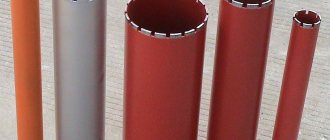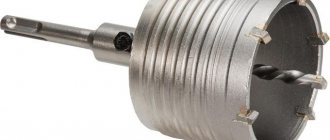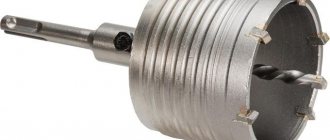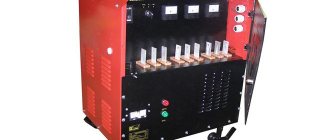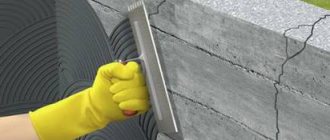Changed and forgot | 01.10.2015
In domestic work (during redevelopment, major repairs, interior changes), the problem often arises of how to make a hole in brick or concrete walls for an outlet, switch or pipes to be laid?
Ordinary drills for wood or metal are, of course, inapplicable in such cases: they will instantly fail. Special tools are needed, including concrete crowns of different sizes (according to the hole diameter) .
The shape of this construction device is a hollow cylinder, the upper edges of which have cutting sections for drilling holes with a diameter corresponding to the diameter of the crown. The cutting part can be made of various materials (pobedit, diamond or tungsten carbide coating) and is significantly harder than concrete.
The back side of the cylinder is a closed side equipped with a fastening element - a flange. Flange shapes may vary, which should be taken into account when purchasing a tool for a specific drill model.
Since this toolkit is often used for drilling holes for sockets, it is called that: a crown for socket boxes for concrete. It is possible to make a hole over 30 mm in diameter using a special crown not only in concrete - a tool with such an attachment can also successfully cope with other types of working materials:
- brickwork;
- concrete with solid filler having a low, medium or high degree of reinforcement;
- artificial and natural stone
The dimensions of the concrete crown are determined in accordance with the diameter of the required hole: this can be the diameter of the socket or the diameter of the pipe.
The scope of application of crowns is quite wide: in addition to installing switches and sockets, they are used when laying or replacing communication lines or electrical wiring.
Characteristics
Crowns for concrete are distinguished by height, outer diameter, type of cutting segments, length of SDS shanks, operating mode and the presence of a centering drill. For design bureaus of large diameters, special equipment is required that ensures the exact position of the hammer drill and the progressive advancement of the cutter into the depth of the concrete or reinforced concrete mass.
The working segments of the bits marked “M” have the property of self-cleaning from concrete dust. Crowns are used to cut out cavities in a monolith of low-strength concrete. Design bureaus of the “T” brand are equipped with hard cutters; they perform drilling at low speeds. The heads are equipped with diamond cutters that easily cope with high-strength concrete.
Design blocks of grade “C” are designed to fit in a monolith of concrete M 200 and M 300. Products of this type are in high demand among the population. Crowns with a diameter of 68 mm and 72 mm are used to cut out seats for hidden electrical wiring fittings.
Selecting Tool Sizes
In order to correctly select the appropriate size crown, you should know the exact diameter of the required hole for the socket, for the cross-section of the pipe or wires when wiring communications.
Each product is accompanied by instructions that indicate the technical characteristics of the product. Crowns can be purchased as a separate tool or as a set of several pieces with different sizes.
Wherein:
- Standard sockets are manufactured with a 68mm mounting box diameter - this is the most popular hole size. Less commonly used are nozzles with a diameter of 70 mm and 75 mm;
- The laying of communication routes is carried out using concrete bits with a diameter of 300 mm;
- When choosing tools, their length and the number of segments of the cutting part are taken into account, which can be 5, 6, 8. With an increase in this indicator, the technical characteristics of the crown improve;
- The set of concrete crowns for holes for socket boxes includes a centering drill, which fixes the tool in the center of the hole, preventing it from deviating to the side;
- The centering drill needs to be changed frequently because it quickly becomes dull;
- A concrete core drill can penetrate concrete to a depth of 1.5 meters.
Core bit with centering drill
Tip: If you have already purchased a socket and you need to determine the diameter of the hole, you should use a caliper to measure the diameter of the outer surface of the socket. The resulting size will be the diameter of the required crown.
Core drill for concrete
Device
A concrete crown (CB) is a glass made of a high-strength steel alloy, into the bottom hole of which an adapter - a cylindrical rod - is inserted. Its one end is clamped into the hammer drill chuck. On the other side of the shank there is a head into which a centering drill is installed.
Diamond or pobedite segments are soldered along the rim of the sleeve, which simultaneously cut through the concrete in a circle and pierce the mass in depth. The shanks (holders) have grooves for longitudinal movement and rotation of the design unit by the hammer drill chuck. Side holes are made in the glasses to dump crumbled concrete into the sleeve so that debris does not interfere with the sliding of the side surface of the crown in the hole.
Before starting work, the end of the holder entering the chuck must be coated with a special lubricant. If this is not done, the moving metal parts in contact will quickly wear out and become unusable.
Types of core cutters
It is important to know. It is not very correct to call these instruments crowns. The fact is that core drills have grooves directed obliquely on the outer surface, which is unacceptable for tools that are used to work with mineral materials. Products with grooves are used for processing plastic, wood and metals.
Core drills
A regular bit for drilling concrete for a socket is equipped with pobedit tips and has a diameter of 6.5 cm. It can be used to drill holes in other mineral materials, for example, bricks, rotband, various types of plaster and putty. The centering drill is secured with a special bolt, so in case of wear or breakage, the drill can be replaced. Also in the modern world, manufacturers began to produce products with a removable shank.
Pobedit concrete core cutter
In the new version of the drill, the cutter itself can be unscrewed from the shank and attached to the extension. With this tool you can drill holes in the wall up to one meter deep. Of course, for such a task, only a drill is not enough; you also need a high-quality hammer drill for drilling concrete with a high-power impact.
Crown with extension
But drilling concrete with diamond core bits does not require a powerful blow. This process follows the same principle as the processing of reinforced concrete structures with diamond wheels. We are talking about abrasive grinding of mineral material. In addition, such drills are convenient to use for processing lined surfaces and drilling holes of sufficiently large diameter.
The fact is that drills with pobedit tips do not gradually grind layers of material, but, in fact, beat off pieces of concrete or any other mineral in a circle. As a result, the rotation does not occur constantly, but spontaneously, so it is very difficult to hold the tool in your hands, not to mention the poor quality of the resulting hole. In addition, if the impact is too strong, there is a risk of knocking off the solder joints.
Return to content
Application
Drilling heads are used to cut out voids in the body of reinforced concrete structures for laying communications (pipes, cables), arranging seats for distribution boxes, switches and sockets.
Crowns are used to drill concrete, brick and stone masonry, both rotary and impact-rotary. During excavation, the walls of the holes do not crumble, and the surface of the concrete fences does not become cracked.
Diamond crowns for concrete do not damage the finishing of walls (ceramic tiles, wood, plastic, etc.). When drilling a hole, a cylinder of monolith remains, which is then knocked out with a hammer drill and chisel in impact mode. This is done carefully, keeping the walls of the recess intact.
Depending on the length of the SDS holders, holes with a depth of 50 mm to 1500 mm are drilled in concrete. To create through passages in adjacent fences, counter-drilling is carried out on both sides.
To prevent overheating of the SDS bit for concrete, the massif is sampled by supplying a stream of water to the drilling zone. At home, the head is periodically moistened with water from a garden spray bottle.
Depending on the diameter, core drills are used for laying communications in reinforced concrete structures of a certain cross-section. Thus, 72 mm concrete drill bits are used to install seats for electrical wiring distribution units. Plastic boxes are inserted into the drilled recesses into which the ends of the wires are brought out.
100 mm concrete crowns are used to create openings into which ventilation pipes are led, diverting air flows from boilers and other heating equipment to the outside. They also have pipelines for air intake from outside.
150 mm crowns are most often suitable for laying sewer pipes. They are used to drill both walls and floor slabs, which is convenient for installing drain lines. Core drills of large diameters (300 mm - 800 mm) are used for wiring special communications in structures and industrial buildings.
Features and types of crowns for concrete
Crowns with pobedite incisors
Concrete drill bits ø 68 mm with carbide segments are used for arranging seats for socket boxes, transfer boxes and switches in apartments, private houses, administrative and public buildings.
The disadvantage of Pobedit concrete crowns for sockets is failure upon contact with reinforcement. The cutters cannot withstand the hardness of the reinforcing steel and fly out of their places. CBs with pobedit segments are also manufactured with a diameter from 35 mm to 120 mm.
Diamond bits for concrete
Cutters are not actually natural diamonds. The name refers to the structure of the segments. They are made from a special mixture of diamond dust and metal powder by cold pressing under high pressure.
Diamond bits for concrete ø 50 mm, 68 mm and 120 mm are used for drilling holes in the enclosing structures of buildings for domestic and general civil purposes. In the construction of industrial facilities, holes with a diameter of up to 800 mm are drilled with crowns.
The main advantage of diamond bits is their passage through metal reinforcement, which is important when working with fences saturated with metal.
Crowns with tungsten carbide coating
The serrated end surface with tungsten carbide coating makes the heads universal in application. They cut holes in tiles and ceramics and then pass through the concrete mass. This saves time by not having to change the cutting head.
However, crowns of this type cannot withstand contact with metal reinforcement.
Features of using crowns
Tool assembly diagram
Carbide bits are usually used in combination with a rotary hammer, with a standard SDS mount, which uses locking and rotating grooves in the shank of the bit. In this case, you can quickly replace the nozzle without clamping keys, and provide it with free movement along the drilling axis, which is necessary for the full impact force on the concrete when making a hole.
Features of the process are as follows:
- Before drilling holes in concrete with a crown, you need to make sure that there is no reinforcement in the wall at the drilling site that could harm the tool;
- The centering drill, if available, is placed in the center of the future hole and drilling can begin;
- In the absence of a centering drill, the cutting edge of the crown is applied to the wall surface simultaneously with all teeth;
Tip: Until the cup of the tool goes deeper into the wall to stabilize the desired direction, you should not apply excessive pressure to it.
- Effective dust removal should be carried out using a construction vacuum cleaner with a special hose attachment;
- A feature of the process of drilling holes in concrete with a crown: the tool does not require periodic cooling, which makes the process continuous immediately to the desired depth;
- When drilling a through hole, the drilled concrete remains inside the cup and is removed along with the crown;
- In case of a blind hole, the concrete remaining in the center of the drilled circle is removed by chipping with a chisel or chisel;
- To speed up drilling with a crown on concrete, you can deepen the tool a small amount, then remove it and drill several holes along the contour of the circle with a Pobedit drill to the desired depth. The diameter of the drill is chosen equal to the width of the teeth of the crown;
- Drilling continues with the same crown.
Tip: During operation, the tool destroys the material only under the thin diamond cutting edge. To protect the cutting edge from severe overheating and eliminate sludge and dust, you should use the option of drilling a hole with a flowing fluid supply.
To obtain high accuracy and quality of holes with diamond core bits, the use of complex technical devices is required that will allow drilling to be carried out without shock and vibration. To facilitate the operator's work, the drilling device should be fixed in a certain way. In this case, you do not need to hold the tool, but only move it in the desired direction.
The video in this article shows you how to properly drill with a crown in concrete, with all the nuances and details.
The three most popular types of concrete crowns
Among the wide range of design bureaus, three types of the most popular hammer drill accessories should be highlighted. These are concrete crowns: Distar, SDS and Zubr.
KB Distar
Distar produces high quality diamond tools. The company is the largest European manufacturer of crowns with diamond cutters. Diamond-coated heads occupy leading positions in various ratings.
Drill glasses with diamond segments 450 – 500 mm long are especially valued. SDS adapters allow you to adapt the tool to almost all types of rotary hammers.
SDS crowns for concrete
Design bureaus are associated with holder designs. These are models SDS, SDS-plus and SDS-max. A standard adapter with a diameter of 10 mm has two longitudinal grooves. Plus shanks have 4 grooves. Two grooves fix the device in the hammer drill chuck, and the other two perform a guiding function. The length of the shank can reach 1 meter.
Max adapters with a diameter of 18 mm are equipped with 5 grooves. 3 grooves guide the drilling head, and the remaining 2 longitudinal grooves act as clamps. Recently, SDS top and quick shanks have appeared on the power tool market. This is a new product from Bosch, which is compatible only with rotary hammers of the same name.
Concrete crown Bison
Zubr concrete crowns have gained a strong leading position in the Russian market. Domestic design bureaus largely owe their popularity to affordable prices for this type of product. The leading Russian manufacturer of power tools, the Zubr company, has established itself as a manufacturer of high-quality concrete drill bits.
Drilling tools on the Russian market are represented by a wide range. These are SDS plus and max holders, drill glasses with carbide cutters of the VK8S brand, bimetallic products with a progressive arrangement of teeth and much more.
KB Zubr with a diameter from 50 mm to 150 mm and a length from 70 mm to 120 mm are equipped with shanks with centering drills. SDS plus and max adapters with a length of 600 – 800 mm are suitable for all products.
